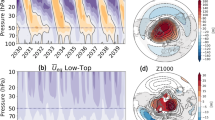Abstract
Atmospheric transient eddies contribute significantly to mid-latitude energy and water vapor transports. Changes in the global climate, as induced by greenhouse enhancement, will likely alter transient eddy behavior. Unraveling all the feedbacks that occur in general circulation models (GCMs) can be difficult. Here, we isolate the transient eddies from the feedbacks and focus on the response of the eddies to simulated zonal-mean climate change that results from CO2-doubling. Using a primitive-equation spectral model, we examine the impact of such climate change on the life cycles of transient eddies. We compare transient eddy behavior in experiments with initial conditions that are given by the zonal-mean climates of GCMs with current and doubled amounts of CO2. The smaller meridional temperature gradient in a doubled CO2 climate leads to a reduction in eddy kinetic energy, especially in the subtropics. The decrease in subtropical eddy energy is related to a substantial reduction in equatorward flux of eddy activity during the latter part of the life cycle. The reduction in equatorward energy flux alters the moisture cycle. Eddy meridional transport of water vapor is shifted slightly poleward and subtropical precipitation is reduced. The water vapor transport exhibits a relatively small change in magnitude, compared to changes in eddy energy, due to the compensating effect of higher specific humidity in the doubled-CO2 climate. An increase in high-latitude precipitation is related to the poleward shift in eddy water vapor flux. Our experiments indicate that the simulation of climate change in eddy water vapor transport and eddy-generated precipitation is sensitive to model resolution and requires a minimum truncation of rhomboidal 30 in a spectral model. Surface evaporation amplifies climatic changes in water vapor transport and precipitation in our experiments.
Similar content being viewed by others
References
Bates GT, Meehl GA (1986) The effect of CO2 concentration on the frequency of blocking in a general circulation model coupled to a simple mixed layer ocean model. Mon Wea Rev 114:687–701
Blackmon ML, White GH (1982) Zonal wavenumber characteristics of Northern Hemisphere transient eddies. J Atmos Sci 39:1985–1998
Bourke W (1974) A multi-level spectral model. I. Formulation and hemispheric integrations. Mon Wea Rev 102:687–701
Branscome LE, Gutowski WJ, Stewart DA (1989) Effect of surface fluxes on the nonlinear development of baroclinic waves. J Atmos Sci 46:460–475
Brenner S, Yang CH, Yee SY (1982) The AFGL spectral model of the moist global atmosphere: documentation of the baseline version. AFGL-TR-82-0393, NTIS ADA 129283, 65 pp
Edmon HJ, Hoskins BJ, McIntyre ME (1980) Eliassen-Palm cross-sections for the troposphere. J Atmos Sci 37:2600–2616
Gall RL (1976) Structural changes in growing baroclinic waves. J Atmos Sci 33:374–390
Grell GA, Kuo YH, Pasch RJ (1991) Semiprognostic tests of cumulus parameterization schemes in the middle latitudes. Mon Wea Rev 119:5–31
Gutowski WJ, Branscome LE, Stewart DA (1989) Mean flow adjustment during life cycles of baroclinic waves. J Atmos Sci 46:1724–1737
Gutowski WJ, Branscome LE, Stewart DA (1992) Life cycles of moist baroclinic eddies. J Atmos Sci 49:306–319
Gutowski WJ, Gutzler DS, Wang WC (1991) Surface energy balances of three general circulation models: Implications for simulating regional climate change. J Climate 4:121–134
Hansen J, Lacis A, Rind D, Russell G, Stone P, Fung I, Ruedy R, Lerner J (1984) Climate sensitivity: analysis of feedback mechanisms. In: Hansen J, Takahashi T (eds) Climate processes and climate sensitivity. AGU, Washington DC, pp 130–163
Krishnamurti TN, Kanamitsu M, Godbole R, Chang CB, Carr F, Chow JH (1976) Study of a monsoon depression (II), dynamical structure. J Meteor Soc Japan 54:208–225
Kuo H (1974) Further studies of the parameterization of the influence of cumulus convection on large-scale flow. J Atmos Sci 31:1232–1240
Manabe S, Stouffer RJ (1980) Sensitivity of a global climate model to an increase of CO2 concentration in the atmosphere. J Geophys Res 85:5529–5554
Manabe S, Wetherald R (1975) The effects of doubling the CO2 concentration on the climate of a general circulation model. J Atmos Sci 32:3–15
Manabe S, Wetherald R (1980) On the distribution of climate change resulting from an increase in CO2 content. J Atmos Sci 37:99–118
Manabe S, Wetherald R (1987) Large-scale changes of soil wetness induced by an increase in atmospheric carbon dioxide. J Atmos Sci 44:1211–1235
Meehl GA, Washington WM (1988) A comparison of soil-moisture sensitivity in two global climate models. J Atmos Sci 45:1476–1492
Michaud R, Derome J (1991) On the mean meridional transport of energy in the atmosphere and oceans as derived from six years of ECMWF analysis. Tellus 43A:1–14
Oort A (1983) Global atmospheric circulation statistics, 1958–1973. NOAA prof pap 14. Dept. of Commerce, Washington DC, USA
Phillips NA (1979) The nested grid model. NOAA Technical Report NWS-22, Dept. of Commerce, Washington DC, USA
Pitcher EJ, Malone RC, Ramanathan V, Blackmon ML, Puri K, Bourke W (1983) January and July simulations with a spectral general circulation model. J Atmos Sci 40:580–604
Schlesinger ME, Mitchell JFB (1987) Climate model simulations of the equilibrium climatic response to increased carbon dioxide. Rev Geophys 25:760–798
Schneider EK (1981) On the amplitudes reached by baroclinically unstable disturbances. J Atmos Sci 38:2142–2149
Sela JG (1980) Spectral modeling at the National Meteorological Center. Mon Wea Rev 108:1279–1291
Simmons AJ, Hoskins BJ (1978) The life-cycles of some nonlinear baroclinic waves. J Atmos Sci 35:414–432
Stone PH, Yao MS (1991) Vertical eddy heat fluxes from model simulations. J Climate 4:304–317
Ulbrich U, Speth P (1991) The global energy cycle of stationary and transient atmospheric waves: results from ECMWF analyses. Meteorol Atmos Phys 45:125–138
Washington W, Meehl G (1984) Seasonal cycle experiment on the climate sensitivity due to the doubling of CO2 with an atmospheric general circulation model coupled to a simple mixedlayer ocean model. J Geophys Res 89:9475–9503
Author information
Authors and Affiliations
Rights and permissions
About this article
Cite this article
Branscome, L.E., Gutowski, W.J. The impact of doubled CO2 on the energetics and hydrologic processes of mid-latitude transient eddies. Climate Dynamics 8, 29–37 (1992). https://doi.org/10.1007/BF00209341
Received:
Accepted:
Issue Date:
DOI: https://doi.org/10.1007/BF00209341




